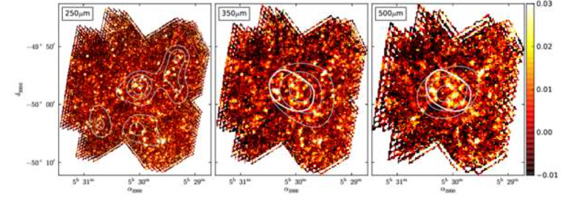
Searching Back in Space for Galaxy Proto-Clusters
Using Steward and space observatories, Steward Observatory Assistant Astronomer Brenda Frye and former Steward Astronomer Hervé Dole have discovered vast complexes of galaxies in the distant universe. Galaxies such as our own Milky Way are usually found near other galaxies in groups or in some cases even in large clusters of galaxies. The galaxy clusters we see today tend to have only older, less active galaxies. Understanding the puzzle of how these galaxy clusters formed and evolved into the relative state of retirement at this present time in cosmic history is a key question in cosmology. Now, using the Planck satellite’s unique ability to produce an all-sky survey of the universe (instead of looking at just one patch of sky as with a ground-based telescope), Frye and collaborators are able to find the earliest examples of these extremely rare and massive galaxy clusters. What is interesting is that all the galaxies in these ‘baby clusters’ are forming stars at the same time, similar to what happens when one plugs in the Christmas lights and the tree gets suddenly bright. It appears that the galaxies in these clusters are not pacing themselves as one would aim to do in a marathon, but rather are using up a substantial amount of energy at the beginning of the race. They ‘turn on’ their Christmas lights all at once, and then later run out of fuel. In a handful of cases they found only a single extremely bright galaxy instead of a whole cluster of galaxies. Frye explains, “This is odd as a single galaxy should not be bright enough to see even with Planck. Understanding how one galaxy can be detected is one of the mysteries that is being solved here at UA”. The answer appears to be that these objects are seen through natural telescopes in space in addition to being seen by Planck. “These natural telescopes take the form of entirely unrelated galaxy clusters near to Earth which bend the light of these distant sources.” Frye observes these special cases with such ground-based telescopes such as the Large Binocular Telescope and the MMT to learn more about these new and enigmatic objects.
A press release can be found HERE and a similar popular article can be found HERE.

For Public
Public events include our Monday Night Lecture Series, world-reknowned Astronomy Camp and Mt Lemmon Sky Center.

For Students
A good place to start if you want to become an undergrad major or grad student, or need to find our schedule of classes.

For Scientists
Find telescopes and instruments, telescope time applications, staff and mountain contacts, and faculty and staff scientific interests.




